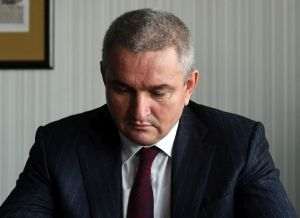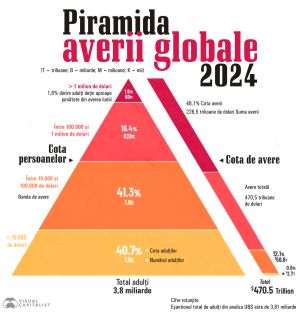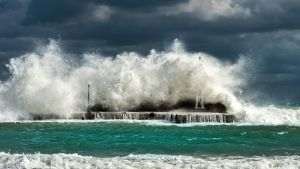The nominal returns of the seven Pillar II private pension funds were around 8%, in the first seven months of this year, respectively 14-16% in the period July 2023 - July 2024, performances above those achieved in normal. They are really positive returns given that inflation, reflected by the Consumer Price Index, was 5.4% this July compared to July last year, respectively 3.2% compared to December 2023, according to data from the National Institute of Statistics.
• Almost 28% increase in the BET-TRN index in the first seven months of this year, respectively 50% in the period July 2023 - July 2024
Economic analyst Aurelian Dochia believes that the performance of pension funds is remarkable, including over longer periods of time, for example ten years, in conditions where there have been big changes in the markets.
"It went from very low or almost negative bank interest rates to very high interest rates, the market of government securities and bonds underwent important movements. The stock market has had ups and downs, but overall it has been growing," Aurelian Dochia told us, emphasizing that the funds' performance comes primarily from equity investments.
In the first seven months of this year, the BET-TRN index, which reflects both the evolution of the share prices of BET companies and the reinvestment of net dividends, had an increase of 27.7%, while in the period July 2023 - July 2024, the appreciation it was around 50%, the best twelve months since our stock market calculates Total Return indices. Compulsory private pension funds invest a quarter of the money they manage in equities, more than 90% of which are in companies in the BET index. Government securities and corporate bonds represent 70% of the funds' portfolios, with the rest being bank deposits or investment fund placements.
• Adrian Mitroi: "The performance of pension funds is linked to the general growth of the stock market, and for the portion of bonds to the general growth of the economy"
Adrian Mitroi, professor of behavioral finance and CFA analyst, points out that the recent performance of pension funds has been exceptional, but that in the long term the annualized return is 7-8%.
The financial analyst told us: "In the theory of investment finance, it is clearly proven that between the two substantial decisions - allocation and selection - the allocation decision has the decisive impact on performance. However, the investments of private pension funds are constrained by the allocation limits imposed by law. Therefore, they cannot add significant value through active management. The added value comes from the investment discipline of Dollar Cost Averaging, from the benefits they had when reinvesting dividends (n.r. which no longer exists because, since last year, funds pay 8% tax on dividends received), from the fact that they participate in auctions without intermediaries and have the lowest costs when buying and selling government securities, they have no marketing expenses, etc."
According to the professor of behavioral finance, the performance of pension funds is linked to the general growth of the stock market, and for the bond portion to the general growth of the economy, but for which a level of 5-6% is not sustainable in the long term. "Because we are entering a natural period of economic growth regression, until we find a new economic model suitable for the new challenges, probably the performance of the funds will also adjust", says Adrian Mitroi.
The CFA analyst added: "Unfortunately, the funds have arrived like a high-class, Olympic swimmer, but one whose pool is not deep enough. They need greater market depth. They don't have enough equity, so it would be wise on the part of the state to list more (n.r. stakes) from the big companies they control. It is the only solution for the further capitalization of pension funds".
• Aurelian Dochia: "There will be initiatives to take over the existing amounts in Pillar II"
Regarding the prospects of pension funds in our country, economic analyst Aurelian Dochia is of the opinion that, given the increasing pressure on the public pension system, there will be attempts to transfer the money collected to Pillar II to supplement state pensions.
He told us: "Despite their good performance, pension funds represent only a marginal source of income for retirees. For the majority, the state pension is the basis of income assurance after retirement, while Pillar II or Pillar III remain marginal; an addition that for many is not a big deal. Or, I think this fact represents a great vulnerability".
Aurelian Dochia continued: "There have been and there will be initiatives to try to practically abolish the Pilon II pension system and use the funds there to supplement the general pension budget, which has been suffering for a long time and will continue to be in suffering. Especially since the demographic situation is changing and there will be a big pressure on the pension budget. Under these conditions, I am sure that there will be initiatives to take over the existing amounts in Pillar II. I don't think there is anyone who can say what will happen, because these decisions have a political component and are influenced by many conjunctural factors. The danger is there, but the fact that the funds have a good performance is a reason for protection, through which they can always demonstrate that they have results that justify their existence".
According to the Financial Supervisory Authority, from the beginning of the private pension system in our country in May 2008 until June of this year, the annualized return of private pension funds was 8.68%, higher than the inflation rate of 4.50 %.
• Adrian Mitroi: "Every person should build a plan that includes an optional pension"
According to behavioral finance professor Adrian Mitroi, along with demographic changes, securing financial resources for old age is increasingly becoming a personal responsibility.
"There is a birth crisis, not only in Eastern Europe, which leads to a systemic crisis in terms of the number of contributors to that of pensioners. Private pensions are the best solution for supplementing the state pension. Every person should build a plan whereby, in addition to the state pension and the mandatory private pension, they have an optional and an occupational pension. Individual responsibility will become increasingly important," the CFA analyst told us.
At the end of July, the net assets of private pension funds in our country were 152.3 billion lei, the average value of the account being almost 17,000 lei. Of the more than 152 billion, only 5.4 billion represented the assets of optional pension funds (Pillar III), while the average value of the account was around 7,000 lei, according to the data available on the website desprepensiiprivate.ro.






















































